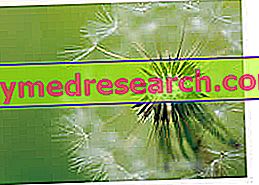Allium sativum L.
Fam. Liliaceae
Br. Ail - Ing. Garlic - Ted. Knoblauch - Sp. Ajo
Areal
Garlic comes from central Asia (Iran and Afghanistan), but it has been cultivated and well known all over the world since ancient times, from China to India, to Egypt.

Culture
Garlic is quite resistant to cold (up to -15 ° C), so it can be planted in autumn (cultivation cycle of 240-270 days) or in spring, in late February (cycle of 140-160 days). The cloves are planted at a depth of 2-4 cm. The plant is quite thick: 10-15 cm on the row and 20-30 cm between the rows, or more in the case of intercropping.
It can be cultivated in temperate zones, but also in the hills and in sheltered mountain areas. It is resistant to drought, so it does not need irrigation. It prefers the loose and well drained soils, able to quickly dispose of excess water, to avoid rotting; the optimal pH is between 6 and 7. With regard to fertilization it is better not to exceed and implement it on the ground before planting; garlic benefits from sulfur, in fact the substances contained that give it its particular odor, contain sulfur. In varieties with inflorescence it is essential to remove it to allow the bulb to grow.
The bulbs are harvested when the aerial part begins to dry out and bends, then the bulbs become dry, but not too long, they are cleaned from the soil and placed in a ventilated place away from the sun (2-3 weeks) then they go into storage.
Yield in 10 m2: from 5 to 15 kg of dry bulbs are collected
In the food field, garlic is used for soups, side dishes, roast meat or sausage dishes. Consuming raw garlic, however, gives the breath a persistent and not always acceptable aroma, which can be attenuated by chewing some fennel or cumin or green anise seed or 1-2 coffee beans.
In agriculture, garlic is used as a repellent plant and for intercropping in organic farming.
History and properties
See also: Garlic - properties and herbal medicine - herbal medicine garlic: properties of garlic - Properties of garlic - Phytotherapy
In ancient Egypt garlic was considered a food with therapeutic properties able to improve the strength and strength of the slaves who built the pyramids.
Many centuries ago Greek doctors Hippocrates and Dioscorides recommended it to treat digestive disorders, leprosy, cancer, wounds, infections and heart problems. During the Second World War the Russian army doctors, who were short of medicines, used garlic to treat wounded soldiers.

Some studies have shown that the integration of garlic in animals has the dual effect of increasing testosterone and reducing cortisol. Therefore garlic appears to be able to increase muscle growth.
Garlic also has positive effects on the circulatory system.
Together with the activity of reducing cholesterol and triglycerides, garlic shows an important anti-platelet aggregation action, antithrombotic and normalizing arterial pressure. As such, it therefore acts simultaneously on several atherosclerotic risk factors.
Some botanists believe that garlic originates from Central Asia.
Garlic contains powerful chemicals that remain isolated until it is cut or crushed. When these substances come into contact with each other, alicin is released, a molecule that gives garlic its typical taste and aroma.
The only disadvantage? Well, whether you like it or not, after eating garlic, its strong smell will give your breath the characteristic fragrance many consider unpleasant. You can mask it all by chewing some parsley leaves or some cloves, or by rinsing with mouthwash.
One last consideration: don't overeat with garlic, moderation is the key to everything, for example if you take too much raw garlic for long periods you run the risk of developing intestinal problems and anemia.
Side effects, contraindications and pharmacological interactions of garlic.



